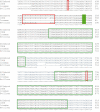Characterisation of the Introgression of Brassica villosa Genome Into Broccoli to Enhance Methionine-Derived Glucosinolates and Associated Health Benefits
- PMID: 35432397
- PMCID: PMC9011106
- DOI: 10.3389/fpls.2022.855707
Characterisation of the Introgression of Brassica villosa Genome Into Broccoli to Enhance Methionine-Derived Glucosinolates and Associated Health Benefits
Abstract
Broccoli cultivars that have enhanced accumulation of methionine-derived glucosinolates have been developed through the introgression of a novel allele of the MYB28 transcription factor from the wild species Brassica villosa. Through a novel k-mer approach, we characterised the extent of the introgression of unique B. villosa genome sequences into high glucosinolate broccoli genotypes. RNAseq analyses indicated that the introgression of the B. villosa MYB28 C2 allele resulted in the enhanced expression of the MYB28 transcription factor, and modified expression of genes associated with sulphate absorption and reduction, and methionine and glucosinolate biosynthesis when compared to standard broccoli. A adenine-thymine (AT) short tandem repeat (STR) was identified within the 5' untranslated region (UTR) B. villosa MYB28 allele that was absent from two divergent cultivated forms of Brassica oleracea, which may underpin the enhanced expression of B. villosa MYB28.
Keywords: Brassica oleracea; MYB28; broccoli; glucoraphanin; introgression; sulphur metabolism; transcription factor; transcriptome.
Copyright © 2022 Neequaye, Steuernagel, Saha, Trick, Troncoso-Rey, van den Bosch, Traka, Østergaard and Mithen.
Conflict of interest statement
The broccoli with elevated glucoraphanin is the subject of patents filed by Plant Bioscience Limited (PBL), the technology transfer company of the John Innes Centre. RM and MHT are inventors named on these patents. FB was employed by Bayer. The remaining authors declare that the research was conducted in the absence of any commercial or financial relationships that could be construed as a potential conflict of interest.
Figures




References
-
- Alexa A., Rahnenführer J. (2009). Gene set enrichment analysis with topGO. Bioconductor Improv. 27 1–26.
-
- Armah C. N., Traka M. H., Dainty J. R., Defernez M., Janssens A., Leung W., et al. (2013). A diet rich in high-glucoraphanin broccoli interacts with genotype to reduce discordance in plasma metabolite profiles by modulating mitochondrial function. Am. J. Clin. Nutr. 98 712–722. 10.3945/ajcn.113.065235 - DOI - PMC - PubMed
Grants and funding
LinkOut - more resources
Full Text Sources
Miscellaneous

